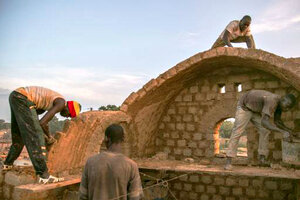For green, comfortable homes, Africans turn to mud
In Mali, domed mud-brick homes are cheaper, protect fast-vanishing local forests, and make homes cooler in worsening summer heat.

Mud rock masons build a home with a vaulted Nubian-style roof in the Sahel.
Courtesy of the UN Climate Change Secretariat
MASSAKO, Mali
Building a house in the poorest villages of southern Mali has for years involved cutting trees for timber frames and struggling to save cash for a corrugated iron roof.
Now families are turning to an alternative: Nubian-style domed mud-brick homes that are cheaper, protect fast-vanishing local forests, and make homes cooler in the worsening summer heat, experts say.
Earthen homes with vaulted brick roofs – a style adopted from Nubia in northern Sudan – are being promoted across the Sahel, including in Burkina Faso, Senegal, and Mauritania, as part of efforts to build resilience to climate change.
"Most people, more than half, don't have the decent housing they dream of because it costs too much to build. This is going to change with the Nubian vault," predicted Chiaka Sidibe,a mason in Massako, one of the Malian communities adopting the new building style.
"You just have to make mud bricks that don't cost money, and fellow villagers help you to build your house," he said.
SAVING TREES
Mud architecture has a long history in Mali, a country known for its picturesque flat-roofed mud mosques and homes built in a style dating from the 13th century.
The new homes in Massako fit that mud tradition – but with the twist of domed roofs.
Mamadou Sidibe, the owner of one of the new-style houses, says building a mud home saved four or five trees that would otherwise have needed to be cut as supports for an iron roof.
"I have no doubt that the Nubian vault will be widely used, though it is new to us," said Mr. Sidibe, who has volunteered to promote the technique to neighbors. "The first reason is the scarcity of the trees that people ordinarily cut to build the roofs of their mud-brick houses."
The cost savings is also significant. Corrugated iron roofing is the most expensive part of building a new home, he said. And homes with iron roofs can be very hot in the summer dry season and chilly in winter.
The heavy walls and strong roof of the Nubian vault houses have drawn praise locally for being well adapted to the climate, with residents saying they alleviate the extreme heat and reduce the severity of some respiratory diseases and those linked to temperature extremes.
TRAINING MASONS
The local office of the Association la Voûte Nubienne, the international non-governmental organization that is promoting the Nubian vault building style, has helped train local builders in mud-brick construction techniques.
The aim is to build a sustainable, self-supporting market for the homes, said Moussa Diarra, the NGO's local coordinator.
"It can take much time to reach this goal but I'm confident the initiative will succeed," he said.
Already, the demand for Nubian vault homes has been soaring in Massako, said Sidibe.
"I wonder how we will handle all these queries before June, when construction will be suspended as it starts raining. We begin building again at the end of the rainy season in October," he said.
The project has been recognized by the United Nations Framework Convention on Climate Change Momentum for Change initiative as an example of the kind of change needed to cut carbon emissions and build greater resilience in the face of climate change impacts.
(Reporting by Soumaila T. Diarra; editing by Laurie Goering)
• This article originally appeared at Thomson Reuters Foundation, a source of news, information, and connections for action. It provides programs that trigger change, empower people, and offer concrete solutions.

